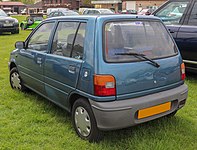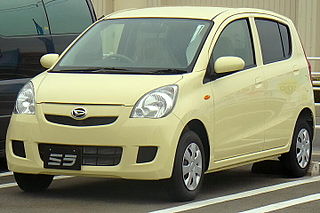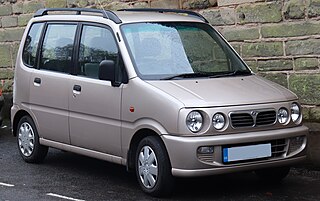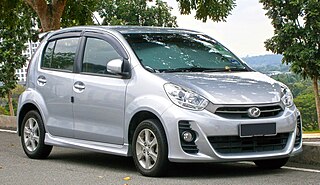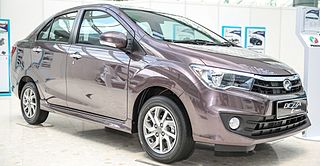History
The Kancil was Perodua's first car after its founding in 1993. [2] It is a small five-door hatchback vehicle on a monocoque framework that can seat five people. The Kancil, like its predecessors, is a slightly modified Daihatsu Mira L200; rebadging is common in Malaysia's automotive industry, having begun in 1985 with first car manufacturer Proton, which based its cars on retired models of Mitsubishi Motors. Subsequent Kancils were only rejuvenated cosmetically as Perodua maintained the monocoque structure and tweaked its engines.
The Kancil is named after the mouse deer, a native animal was commonly found in Malaysian jungle. The car was available with two engines, a 660 cc version with 31 PS (23 kW) and an 850 with 37 PS (27 kW). Four- or five-speed manual transmissions were available (four-speed was not available in the 850) or a three-speed automatic. [3]
The Kancil was unveiled on the 29th of August 1994. [4] At launch two variants were on offered: EX and GX both powered by a 660 cc engine and both paired to a manual transmission. 4-speed manual for the EX and 5-speed manual for the GX. [5]
In January 1995, the Perodua Kancil EZ was launched. It came with an automatic transmission and in addition to the existing equipment on the GX variant, there was colored bumpers, gear lock, side protector molding, hazard sign and the first-aid kit for metallic and mica models only. It was launched at RM28,931.14 for the solid colors (Kristal White and Bunga Raya Red), RM 29,838.14 for the Metallic version (Kilauan Silver) and RM 30,214.00 for the Mica version (Blue Mica) in Peninsular Malaysia. [6]
In August 1996, the Perodua Kancil 850cc version was launched. It came with both GX (manual transmission) and EZ (automatic transmission) variants in addition to the existing 660cc version. Their features and colours are carried over from both GX and EZ of 660cc version, with additional of front power windows, and with Violet Purple colour instead of Blue Mica and Classic Blue. Their prices were quite little higher than 660cc versions because of the bigger 850cc engine volume and power, as well as the latter additional equipment. Besides both variants, the additional 850cc GX based Kancil Era variant was also introduced. [7]
On 27 August 1997, the Perodua Kancil was facelifted. Changes included new design for the larger front grille, rear garnish, rounded indicator lights, clear rear signal lenses (amber in pre-facelift) and different wheel caps designs, new cabin upholstery with the use of improved seat fabric and 2 front washer nozzles. The Kancil 850 cc series, got new white faced metres and adjustable head rest. Prices were between RM 24,833.74 to RM 33,465.84. [7]
On 3 May 1998, the Perodua Kancil EX extra was launched. It came with a 660cc engine and 5-speed manual transmission. [8] Around the same time, the Kancil 850cc series was updated with the use of different upholstery on the door cards and seats. Lastly, a centre console with storage area and coin slots replaced a simple rubber boot.
On 14 October 1999, Prime Minister Mahathir Mohamad unveiled the new look Perodua Kancil and launched Perodua e-shoppe during the opening of the KL Motorsport Show 99. This is the second facelift for the Kancil since it was first launched in August 1994. [9]
In 2000, the car was given another slight facelift consisting of body-coloured side mouldings, a new grille and reprofiled front bumper with larger indicators, and electrical adjustable side mirrors were equipped for 850cc models.This facelift was available with three variants: 660 EX, 850 EX and 850 EZ. [10]
The Kancil received a more extensive restyling in September 2002, [2] featuring rounder headlights, taillights and bumpers; its rear license plate was also repositioned onto its hatch from the bumper below. Its interior features a flushed dashboard with the combination instrumentation panel placed in the middle similar to that of the Toyota Yaris. However, it is still mechanically identical to its predecessor, except for the EZi automatic transmission variant which was given a fuel-injected powerplant though this variant wasn't available at launch. Perodua cited Daihatsu’s thorough testing procedures and the engine being made locally with many local component for the EZi variant to be only introduced later on. At launch only manual transmission equipped variants were available: 660EX and 850EX. [11]
In February 2003, the Perodua Kancil EZi was launched. It came with an automatic transmission and an electronic fuel injected engine. [12] Between June [13] and August 2004, [14] a 660 EXb variant or 660 EX Basic variant was made available as the new base model. Notable omissions from the 660 EX variant included the passenger visor, a clock, door visors, rear wiper, a radio with speakers and an alarm with central locking. Solid Ivory White was the only colour option for this variant. [15]
Between May [15] and December 2005, [16] a 850 EXS variant was made available. This variant stood for special edition and was priced not much different to the 850 EX variant which it shared the same powertrain (engine and transmission combination) with. Key features of this variant included 12" alloy wheels like on the 850 EZi variant, a CD player. skirting/bodykit, blue graphics for the instrument cluster, silver painted centre cluster and a leather wrapped steering wheel. Metallic Ebony Black and Metallic Glittering Silver were the only two colour options for this variant. It is interesting to note that other variants either had no radio or a radio with cassette making this variant the only Kancil variant to come with a CD player. [15]
From July 2005 a tuned Kancil SE version was also available. [17] Between February [18] and March 2008, [19] both the 850 EXS and 850 EZi model was dropped. Production of Kancil ceased on 20 July 2009 and replaced by the Perodua Viva. [20]










